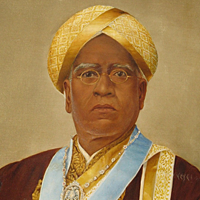K. Seshadri Iyer
Kumarapuram Seshadri Iyer KCSI, was an Indian advocate who served as the Dewan of Mysore from 1883 to 1901. He was the second Dewan of Mysore state since the reinstatement of the Wodeyar family on its throne in 1881 and was the longest serving Dewan of the princely state as well.
Kumarapuram Seshadri Iyer (or Aiyar) KCSI (1 June 1845 – 13 September 1901), was an Indian advocate who served as the Dewan of Mysore from 1883 to 1901. He was the second Dewan of Mysore state since the reinstatement of the Wodeyar family on its throne in 1881 and was the longest serving Dewan of the princely state as well. He is regarded by most as the Maker of Modern Bangalore.
Seshadri Iyer was born in a family from Palghat in the Malabar district of Madras Presidency which is in modern day Kerala. He had his early education in Calicut and graduated in arts from Presidency College, Chennai, in 1868. He was also a qualified lawyer.
Seshadri Iyer joined the services of the Mysore kingdom in 1868 and served as a district magistrate and later as Personal Secretary to the Diwan, Rungacharlu before being appointed Diwan himself. Seshadri Iyer was the longest serving Diwan of Mysore kingdom and served from 1883 to 1901.
Started the Mysore Civil Service Examinations were held for the first time in 1891 and the Department of Geology and the Department of Agriculture were founded in 1894 and 1898. Other notable achievements include the construction of the Vanivilas Sagar dam across Vedavati river, the initiation of the Shivanasamudra hydroelectric project in 1899 (the first such major attempt in India), electricity and drinking water (the latter through pipes) being supplied to Bangalore and the founding of the Archaeological Survey of Mysore (1890) and the Oriental Manuscripts Library.
Seshadri Iyer established the Kolar gold fields and Victoria Hospital and commissioned the Shivanasamudra hydel-electric power project. Seshadri Iyer had to deal with a devastating plague which afflicted Bangalore in 1898 and was responsible for the decongestion of streets and reconstructing the city in the aftermath of the plague.
Seshadri Iyer was born to Ananthanarayanan Iyer and his second wife Venkatalakshamma at Kumarapuram near Palghat.
Ananthanarayanan Iyer was employed as a vakil (lawyer) in Calicut. Seshadri Iyer was educated in private until his eleventh year when he was admitted to the Free Church Mission School in Cochin. Seshadri had his higher education at the Calicut Provincial School and the Trivandrum High School from where he matriculated in first class in 1863 winning the Connoly Scholarship. Seshadri was admitted to the Presidency College, Madras where he was mentored by E. B. Powell. Seshadri graduated in 1866 emerging first in the B. A. examinations.
In 1868, Seshadri Iyer was appointed Judicial Secretary in the Ashtagram division of the Mysore kingdom. He later served as Head Sheristadar of the Court of the Judicial Commissioner, Assistant Commissioner of Mysore, Deputy Commissioner and District Magistrate of Tumkur and District and Sessions Judge of Ashtagram division.
He obtained his B. L. degree from the University of Madras in 1874. From 1881 to 1883, he served as an officer on special duty in Mysore. In 1883, when Rangacharlu’s period of service came to an end, Seshadri Iyer was appointed Diwan of Mysore.
Seshadri Iyer succeeded Rangacharlu as Dewan of Mysore in the year 1883 and administered Mysore for a span of eighteen years. He remains the longest serving Diwan of the princely state. He worked to improve the transport, irrigation and mining sectors in the kingdom. Seshadri Iyer extended the railway lines in the kingdom by 270 kilometres (170 mi)

K. Seshadri Iyer
Date of Birth: 01 Jun 1845
Birth Place: Palakkad
Proffession: Indian advocate
Nationality: Indian
Death: 13 September 1901, Mysuru


